Common name: Spurge family
Number of genera: This family includes 300 genera and about 5000 species
Propagation type: Fruit or seed
Distribution: The members of this family are cosmopolitan in distribution but, they are more abundant in warmer parts or tropical regions of the world. They are almost absent in Arctic region. In India this family is represented by 61 genera and 336 species. All these species are distributed in tropical and sub-tropical Himalayas and mountain ranges of south India.
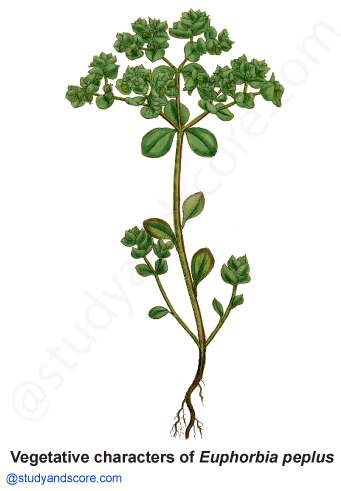
Habitat: Generally, plants belonging to this family are Mesophytic or xerophytic in habitat
Habit: This family shows a great range of characteristics in vegetative and floral structures. Members of this family are mostly shrubs (for example Jatropa, Ricinus, Euphorbia sps.) or trees (for example Emblica officinalis, Hevea brasiliensis) and rarely herbs (for example Acalypha, Phyllanthus).
The species of Tragia are climbers. Several species of Euphorbia (like E. royleana, E. neriifolia and E. trigona) are cactus like in habit with thick, fleshy stems and with leaves reduced to spines. These plants contain milky latex in special laticiferous vessels.
Root system: These plants show tap root system. Exceptionally, Manihot has tuberous roots which are rich in starch. Few species of Manihot are edible.
Stem: Several species of Euphorbia are cactus-like in habit with thick and fleshy stems and leaves reduced to spines. These plants often contain milky latex with special laticiferous vessels.
Leaf: The leaves are usually alternate or rarely opposite (Choriophyllum) or whorled (Mischodon), simple, entire or deeply palmately lobed (Ricinus and Jatropa) or compound (Bischofia). The leaves are variegated in Croton.
The stipules are usually present and in Jatropa they are represented by ciliate glands. The venation is pinnate or palmate as in Ricinus. In species of Euphorbia, leaves fall off early and photosynthesis is carried by green stems.
Inflorescence: Inflorescence is complex and highly variable. In Phyllanthus, the flowers are solitary or auxiliary. In Croton, the inflorescence is panicle. In Acalypha, it is catkin and in Jatropa the flowers are arranged in terminal cymose clusters.
The first branching is usually racemose and the subsequent branchings are cymose. The partial inflorescence is a cyathium which appears as a single flower. Each cyathium is surrounded by an involucre of four or five connate bracts and between these large coloured glands a petaloid appendage is present (Splendens).
In the middle of cyathium, there is a single female flower represented by a tricarpellary gynoecium. In the axil of each bract a number of male flowers are arranged in scorpioid cymes. The oldest flower is nearest to the centre and thus the maturation is centrifugal.
In Euphorbia both male and female flowers are naked, whereas in anthostema both have a tubular perianth. In the remaining genera of this tribe, male flowers are naked and female flowers have rudimentary perianth.
Flower: The flowers are unisexual, bracteates, actinomorphic, regular, pentamerous or trimerous (Phyllanthus), monochlamydeous and hypogynous. The flowers are rarely perigynous as in Bridelia.
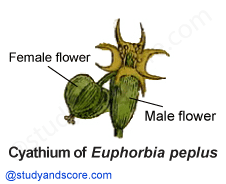
Perianth: Perianth is mostly in one whorl, green or rarely petaloid (Manihot). Rarely perianth is in two whorls as in Jatropa or absent as in Euphorbia. In Jatropa, both calyx and corolla are present. Both calyx and corolla are five membered with united petals. Aestivation is valvate or imbricate type.
Androecium: The Androecium show variable number of stamens. In male flowers they range from one to many arranged in one to ten whorls. Filaments are free or united. The anthers are monothecous or dithecous, erect and dehisce longitudinally or transversely.
For example,
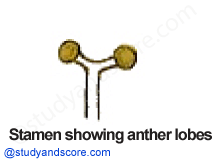
Filaments are free or united. In Phyllanthus cyclanthera besides filaments the anthers are also united into a ring-like common anther. In Ricinus, branched stamens are present opposite to the sepals. Here anthers are borne on the ultimate branch. The anthers are dithecous, erect and dehisce longitudinally or transversely. A rudimentary ovary is often present in the male flower.
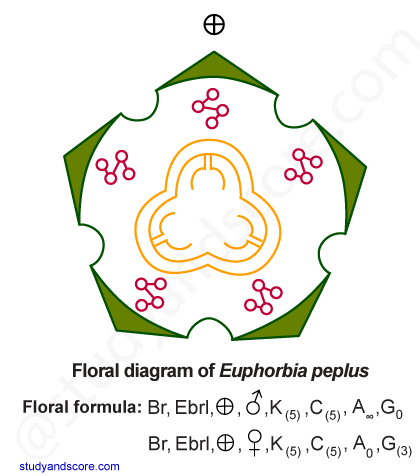
Gynoecium: The gynoecium is tricarpellary, syncarpous with superior, trilocualr ovary. One or two collateral, pendulous, anatropous ovules in each locule in axile placentation are present. At the base of the ovaries nectarines are present.
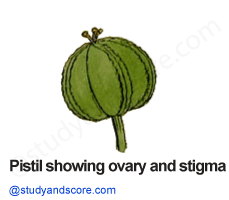
Pollination: Unisexual flowers necessitate cross pollination and here pollination is entomophilous taking place with the help of insects. This is due to the presence of brightly coloured glands or bracts, petaloid calyx or nectar. Certain taxa, such as Mercurials with long thread like styles are anemophilous.
Fruit: Fruit is usually three chambered, schizocarpic splitting into three one-seeded cocci. Rarely drupe (Phyllanthus) or berry (Bischofia).
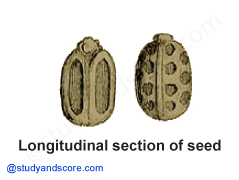
Seed: Seeds are with fleshy endosperm and straight embryo. The seeds are often with a conspicuous caruncle. Seeds are dispersed by birds and animals. Some seeds are also dispersed by explosive mechanism of the capsules.
The following is a list of some important members of family Euphorbiaceae, arranged alphabetically.
Plants of Euphorbiaceae are economically very important. They provide food, drug, rubber and oil
Edible plants
Rubber
Medicine
Dyes
Oils
Ornamentals
Some of the plant species of this family which are ornamental are as follows,
Hope you have liked this post.
Please share it with your friends through below links.
All the very best from Team Studyandscore
“Study well, Score more…”
- Share with your friends! -
Login to post your comment here...
- or with social Account -